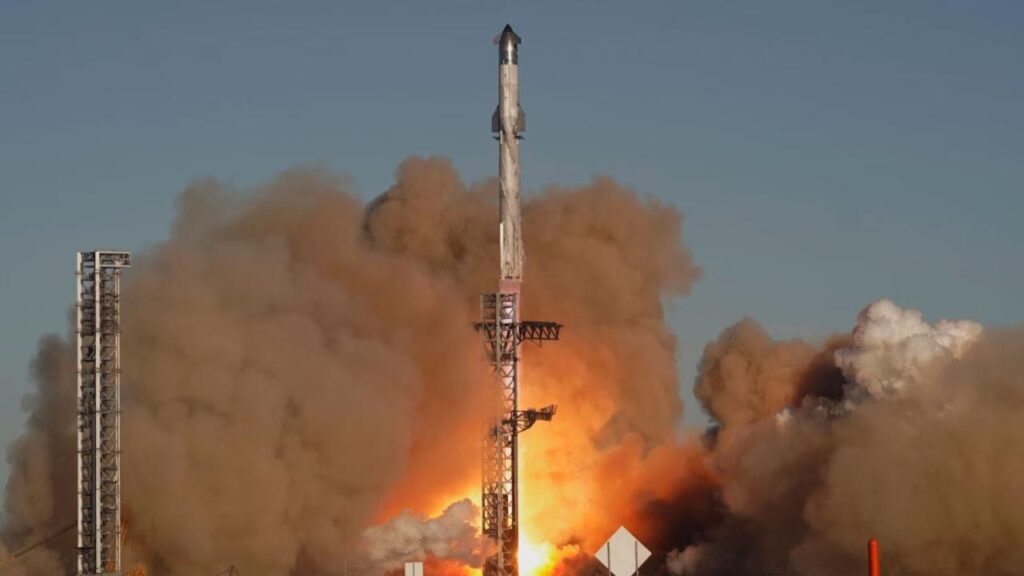SpaceX’s Starship 9th test flight was meant to be a historic milestone in humanity’s journey to Mars. Instead, it ended in what Elon Musk might casually call a “rapid unscheduled disassembly.” On May 27, 2025, the rocket lifted off from Starbase, Texas with high hopes, aiming to break new ground in reusable spaceflight. And while some parts of the mission were a success, others? Not so much.

The Starship-Super Heavy combo did hit key marks like liftoff and reaching orbital velocity, but the test ultimately ended in dual explosions—both stages were lost. That might sound like failure to some, but for SpaceX, it’s just part of the ride to the stars.
SpaceX Launches… Then BOOM!
| Feature | Details |
|---|---|
| Launch Date | May 27, 2025 |
| Vehicle | Starship Ship 35 + Super Heavy Booster 14-2 |
| Mission Objectives | Reach orbit, deploy Starlink simulators, safe splashdowns for both stages |
| Liftoff Time | 6:36 PM CDT (23:36 UTC) |
| Main Issues | Payload deployment failure, attitude loss, reentry breakup, booster explosion |
| Achievements | First orbital velocity reached, no heat shield tile loss, first reused Super Heavy |
| Outcome | Both stages destroyed, valuable data gathered |
The 9th test flight of Starship didn’t stick the landing—literally. But it pushed boundaries, scored some wins, and gave engineers a treasure trove of data. For SpaceX, blowing up a rocket isn’t the end. It’s a fiery beginning to something bigger.
What Was the Point of This Starship Launch Anyway?
To understand what SpaceX was up to, we’ve gotta take a step back. The Starship system is the company’s big bet on the future—think Mars colonies, lunar bases, point-to-point Earth flights, you name it.
This test flight was meant to:
- Fly into low Earth orbit
- Deploy mass simulators (fake Starlink satellites used for practice)
- Safely bring back both stages to splash down in water
- Test a bunch of critical systems like heat shielding, reentry control, and engine restart
In theory, this flight could’ve been a proof-of-concept that full reusability is just around the corner.
So… What Went Right?
Let’s give credit where it’s due—this launch wasn’t a total bust. In fact, there were several major “firsts” here that SpaceX engineers are probably still cheering over.
Liftoff and Stage Separation? Nailed It.
The Super Heavy Booster 14-2 did its job flawlessly, pushing Starship into space. Notably, this booster was reused, marking the first time SpaceX recycled a Super Heavy vehicle.
That’s huge. Reusability is the Holy Grail of rocketry, and SpaceX is dead-set on making it the norm.
Reached Orbital Velocity
This is a big deal. Unlike earlier high-altitude hops or suborbital jaunts, this Starship test actually made it to orbit. That means it flew around Earth fast enough to stay up—at least until reentry.
What Went Horribly, Spectacularly Wrong?
Let’s not sugarcoat it—this flight blew up. Literally. But in spaceflight, especially experimental testing, that’s kinda expected. Still, here’s what went sideways.
1. Payload Deployment Failure
The mass simulators (stand-ins for Starlink satellites) were supposed to be deployed from the payload bay. Problem is, the payload bay door didn’t open. That’s a pretty hard fail for any orbital mission.
2. Attitude Control Loss
A propellant leak messed up tank pressure. That led to Starship losing its ability to orient properly in space. Without control, the vehicle couldn’t align itself correctly for reentry.
Imagine trying to belly flop into a pool but twisting halfway through—you’re gonna slap the water hard. That’s what happened to Starship.
3. Reentry Breakup Over Indian Ocean
Because it couldn’t point its heat shield toward the atmosphere, the ship burned up and disintegrated during reentry. No recovery. No soft splashdown. Just vaporized metal.
4. Booster Explosion
The Super Heavy booster was supposed to splash down in the Gulf of Mexico. Instead, it exploded mid-descent, likely because of an overly aggressive reentry profile. Yikes.
Why This “Failure” Still Matters
If you’re wondering why SpaceX and Elon Musk aren’t crying in a corner, here’s why:
- The heat shield tiles didn’t fall off this time—previous flights had that problem.
- They gathered tons of telemetry and video to figure out what went wrong.
- Each failure teaches SpaceX how to improve. That’s baked into their engineering culture.
This flight is part of a rapid iteration model—fly fast, fail fast, fix fast. It’s how they turned Falcon 9 into a reusable workhorse.
Elon Musk’s Response: Classic Elon
After the flight, Elon Musk tweeted, “Well, that was spicy. Learned a ton. Starship is improving fast.”
While not exactly an engineering breakdown, it speaks volumes. Musk and SpaceX see these failures not as setbacks but as tuition paid to the universe. And the universe, folks, charges a hefty price.
What’s Next for Starship?
According to SpaceX, they’re already prepping the 10th orbital test flight. And it might come as soon as June or July 2025.
Expect:
- Improved payload doors
- Tighter control systems
- Better reentry strategies
- More attention to propellant pressurization
Also, expect them to keep testing roughly every 3-4 weeks, a cadence unheard of in traditional space agencies. That’s part of what sets SpaceX apart.
Starship and NASA: Are They Still BFFs?
You bet. Despite this failure, NASA still depends on Starship for its Artemis Moon program. Starship will serve as the Human Landing System (HLS) for upcoming lunar missions.
That means it’ll take astronauts from lunar orbit down to the Moon’s surface. So yeah, even if it exploded this time, Uncle Sam is still on board.
Starship’s Bigger Picture: Mars, Moon, and Beyond
This isn’t about satellites or flashy launches. It’s about humanity’s next chapter. Starship is designed to carry over 100 people, refuel in orbit, and eventually land on Mars.
Each test brings us a step closer to that goal. Even when they end in fireballs, they light the path forward.
Trump Calls Biden a ‘Decrepit Corpse’—Just Days After Stage 4 Cancer Reveal
Trump vs. Harvard: The Secret Battle That Could Shake U.S. Education
Frequently Asked Questions (FAQs)
What is SpaceX’s Starship?
Starship is SpaceX’s next-gen rocket designed for deep space missions, including Mars colonization, Moon landings, and rapid Earth travel. It’s the most powerful rocket ever built.
Why did Starship’s 9th test flight fail?
The test flight failed due to a payload bay door malfunction, propellant leak, attitude control issues, and failed reentries for both the ship and booster.
Did the rocket reach orbit?
Yes! This was the first Starship test that successfully reached orbital velocity, though it failed to complete its full mission objectives.
Is this the end of the Starship program?
Not at all. SpaceX plans to continue testing frequently. Failures are considered part of the process to refine the system for future use.
Where can I watch the full launch video?
You can watch the official footage here: Starship | SN9 | High-Altitude Flight Test










